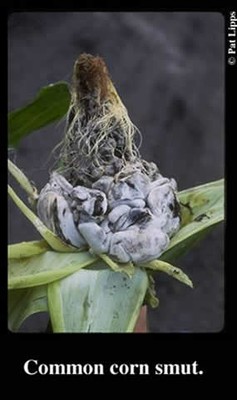 Common Corn Smut in ears at R5 Source: P. Thomison, OSU |
 Source: P. Lipps, OSU Plant Pathology |
Symptoms:
The smut gall is composed of a great mass of black, greasy or powdery spores enclosed by a smooth white covering of corn tissue. The gall may be 4-5 inches in diameter. The corn plant may be infected by smut at any time in the early stages of growth, but becomes less susceptible after the formation of the ear. Above-ground parts may be infected, but it is more common to see the smut galls on the ears, tassels, and nodes than on the leaves, internodes, and brace roots. After the spores mature, the covering becomes dry and brittle, breaks open, and the spores sift out. Greatest yield losses occur when the ear becomes infected or if the smut gall forms on the stalk immediately above the ear. Common corn smut is not associated with mycotoxins. In Mexico, immature smut galls are consumed as an edible delicacy.
Cause:
Corn smut is caused by the fungus, Ustilago zeae, that survives as a resistant spore over winter, and possibly for 2 to 3 years in the soil. These spores can be blown long distances with soil particles or carried into a new area on unshelled corn and in manure from animals that fed on infected corn stalks. Spores germinate in rainwater that has collected in the leaf sheaths. This leads to infections that are visible in 10 days or more. Wounds from various injuries (including hail, wind, and insects) provide points for the fungus to enter the plant.
The smut fungus is sensitive to temperature and moisture changes. In a warm season, the amount of smut is related closely to the amount of moisture in the soil especially during June. When temperatures are lower than normal, there may be little smut even though soil moisture may be high.
Management:
Seed treatment is of no value for smut control because few spores are on the corn seed.
Spraying for corn borer control helps in cases when insect populations are high. Avoid injury of roots, stalks, and leaves during cultivation. Tillage to bury diseased corn stalks in the fall will help give some control.
References:
White, Donald G. (ed.). 1999. Compendium of Corn Diseases (3rd Edition). APS Press, The American Phytopathological Society.

